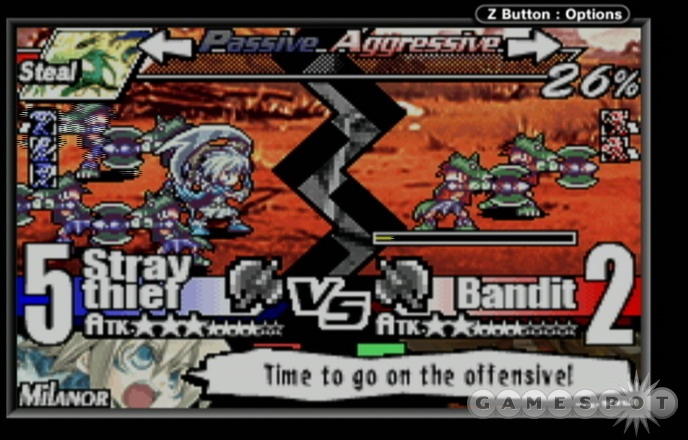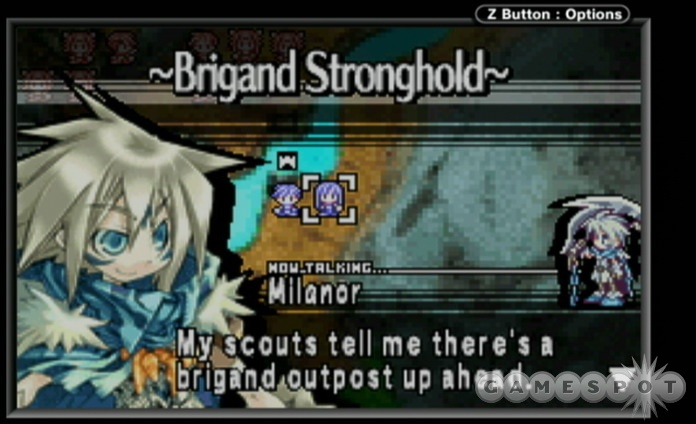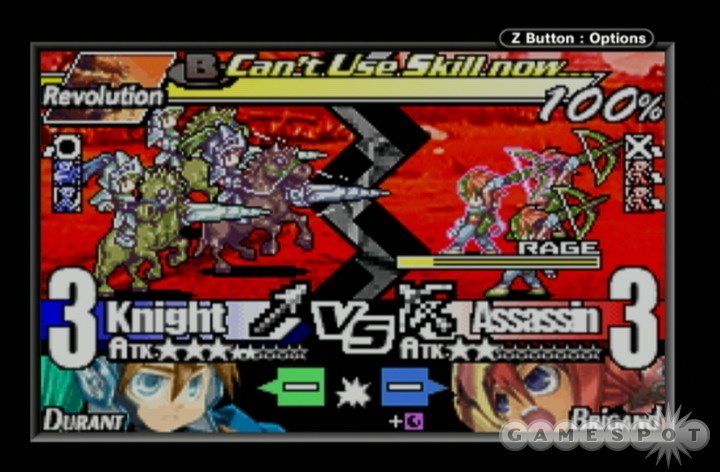What's a princess to do when her castle is suddenly besieged by a ruthless neighboring empire? Fight back, that's what--and there's plenty such fighting to be had in Yggdra Union, a complex strategy role-playing game for the Game Boy Advance. If you've played and enjoyed other strategy RPGs like the Fire Emblem games, Final Fantasy Tactics Advance, or Tactics Ogre, then you'll find that this one shares a lot of common themes, yet the gameplay itself is utterly different. So different, in fact, that Yggdra Union has an unusually steep learning curve, layering abstractions upon abstractions and taking many unconventional approaches to this style of game. This isn't a bad thing--quite the contrary--though it means you'll need to be patient to appreciate this unusual game.

The story of Yggdra Union is fairly straightforward anime fantasy stuff, but it's well written and establishes some likable characters in the determined young Princess Yggdra and her adventurous companion, a scruffy leader of a band of thieves named Milanor. The two partner up early on in an attempt to restore order to the kingdom and reroute the rampaging imperial invaders. The princess is an inexperienced fighter, but Milanor knows how to handle himself in battle, so he teaches her (and you) the ropes during some of the early scenarios. Their quest is joined by survivors of Yggdra's royal military and then by other unlikely characters, and the scope of the battles they all face gradually escalates into full-on war. This lengthy game is divided up into a series of chapters, each containing multiple battles that you must successfully complete. Story sequences bookend each battle and often crop up between mission objectives in the middle of a battle, and you also get some time to equip your characters between each fight. However, the meat of the gameplay is on the battlefield.
In the simplest terms, Yggdra Union plays out like a turn-based strategy game, in which you alternate turns with the enemy, taking care to use your best-suited forces against the opponents' most vulnerable units. You see the tactical map from a bird's-eye view, but when units engage in battle, the scene switches to a dynamic side view in which combat between opposing armies is resolved. You'll get to use weapons like swords, spears, and axes, as well as bows, magic spells, and a variety of special abilities. Different unit types include your various fantasy mainstays, though Yggdra Union has a fairly distinctive anime art style that gives this game an exciting, attractive look. Big, colorful portraits of all the different characters and unit types help give this game its personality, though it would have been nice if the character portraits were animated during the story sequences. During battle, you'll see your characters' facial expressions change depending on how the fight's going.
All of this might sound pretty conventional if you've played other games of the sort, but Yggdra Union plays much differently from other, better-known strategy RPGs. Some of the notable differences include how the game deeply incorporates a card-battling system. You'll find more and more unique cards as the game progresses, and before each turn, the first thing you do is play one of these cards. Your cards influence how much you can move in each turn, how powerful your attacks will be in that turn, and which special abilities you'll be able to use in that turn. Most special abilities are available only to certain types of characters, and on top of that, they can be used only if the appropriate character leads the charge into battle during that turn. All this isn't necessarily as complicated as it sounds, because the game eases you into the card system and the skill system, rather than forcing you to figure it all out the hard way. However, certain gameplay concepts, like how you can initiate an attack only once per turn and how the number of steps you can move is shared across all your characters, are quite strange and take getting used to. It's conventional in these types of games for all of your characters to be able to move and attack in a given turn; Yggdra Union doesn't work like that.

The "Union" part of the game title comes into play when you initiate an attack. Though you can initiate an attack only once per turn, nearby characters will fight sequentially, as will nearby enemies, so it's possible for many rounds of combat to resolve in a given turn. A key part of the strategy, then, revolves around strategically positioning your characters so that your forces can lay into the most vulnerable enemy forces. As in the Fire Emblem games, there's some rock-paper-scissors-style balancing at work between different weapon types, so your spear-wielding knights will have a good advantage against a group of fencers but will have a harder time against axe-wielding bandits. But it's not nearly as simple as that, because you also have to take terrain and other factors into consideration, and the attacker tends to have an advantage by getting to charge the enemy and strike first.
One other weird thing about Yggdra Union is that your units, which represent individual armies, don't have hit points or health--they have morale, and each time they lose a fight, they lose some of that morale. When morale hits zero, the unit is defeated, and if that's one of your main characters, game over. Unfortunately for you, morale doesn't automatically regenerate between battles, and is restored primarily by using items you'll have in short supply. This contributes to making the game quite difficult and occasionally quite frustrating, as you'll often face a particularly tough foe at the very end of a mission, only to lose and have to start over. Thankfully, you retain the experience levels you've earned if you have to replay a mission, so missions naturally get a little easier the more times you're forced to retry them.
The morale system seems rather awkward, because it adds a layer of abstraction on top of the individual battles. When two units clash, you'll see the two opposing sides apparently fight to the death, right on down to the unit leader (for instance, Princess Yggdra herself) collapsing on the battlefield. But this doesn't mean the unit's been wiped out; it just means the losing unit is going to take a morale hit, and a variety of factors affect how much of a morale hit that's going to be. As long as the unit has morale remaining, it lives to fight another day, and in subsequent fights it'll once again be at full strength. At any rate, it takes a few hours to wrap your mind around all of Yggdra Union's unusual design decisions, which seem pretty arbitrary in a lot of cases, but they're mostly interesting.

Probably the main issue with the gameplay is simply the pacing, which winds up being pretty slow. The battles are exciting to watch for a while, but they do start to become monotonous after some hours. And once special abilities come into play, those slow things down further, because each time such an ability is used, there's some sort of elaborate special effect that interrupts the action for a few seconds. Other, similar games let you optionally skip the combat animations, but Yggdra Union forces you to watch them every time. Granted, the combat is somewhat interactive, since not only can you strategically use your skills, you can also switch between an aggressive and passive posture to influence the results of the fight. But the biggest factor in a battle is statistical in nature, so the most important choices you make occur before any armies collide.
Yggdra Union features a busy but attractive presentation. In addition to the colorful anime graphics and nicely animated combat sequences, there are some catchy musical melodies and convincing digitized sounds of combat. You see a dozen units fighting onscreen in a given skirmish, but this convincingly creates the sense that whole armies are fighting head-on. The presentation turns out to be telling about the entire game: There's a lot going on in Yggdra Union, and it all seems interesting but also somewhat dense and intimidating. Once you get past the learning curve and settle into the pacing of the game, you'll find in Yggdra Union another good reason to keep your Game Boy Advance or Nintendo DS juiced up for many days to come.